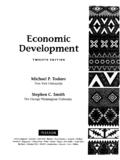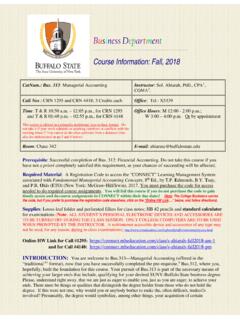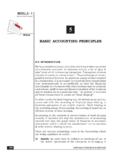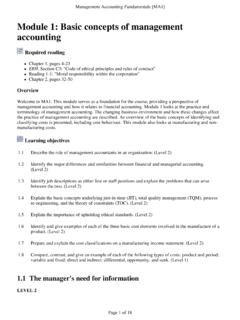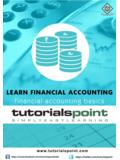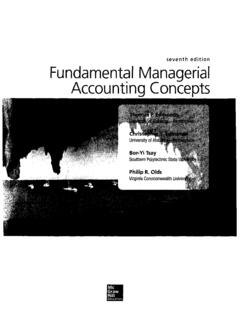Transcription of Fundamental Financial and Manageria Accounting …
1 FundamentalFinancial andManageriaAccountingConceptsUnivers1-; *Th<tMnas#P,,;Edmonds' :j:.. ^'%v::' '* . " ' ity||)f::Ajabama BirminghamOniyersity of i. Edmonds'Birmingham^i:^'-^tV-r' ':':v,Virgit1i:a:Commo weatthi3niVers:ity'IO;;.^^" Frances M. McNair^';I'SC' Mississippi'StatesUriiversity?'"Universi ty,6f Alabama- Birmihgham .. '' : .! J^Nancy W. Schneider JJ .. ', Lynchburg College . xj iEdward E. Mi lamMississippi State UniversityMcGraw-HillIrwinBoston Burr Ridge, IL Dubuque, IA Madison, Wl New YorkSan Francisco St. Louis Bangkok Bogota Caracas Kuala LumpurLisbon London Madrid Mexico City Milan Montreal New DelhiSantiago Seoul Singapore Sydney Taipei TorontoContentsChapter 1 Elements of Financial Statements 2 Chapter Opening 3 Role of Accounting in Society 4 Using Free Markets to Set ResourcePriorities 4 Accounting Provides Information 5 Types of Accounting Information 6 Nonbusiness Resource Usage 6 Measurement Rules 6 Reporting Entities 8 Elements of Financial Statements 8 Accounting Equation 9 Recording Business Events Under theAccounting Equation 11 Asset Source Transactions 11 Asset Exchange Transactions 12 Another Asset Source Transaction 12 Asset Use Transactions 13 Historical Cost and ReliabilityConcepts 14 Recap.
2 Types of Transactions 14 Summary of Transactions 14 Preparing Financial Statements 15 Income Statement and the MatchingConcept 17 Statement of Changes in Stockholders'Equity 17 Balance Sheet 1822 Statement of Cash Flows 18 The Horizontal Financial StatementsModel 19 Careers in Accounting 20 Public Accounting 20 Private Accounting 21 The Financial Analyst 21 Importance of Ethics 21 Sarbanes-Oxley Act of 2002 Common Features of EthicalMisconduct 22 Real-World Financial Reports 24 Annual Report for The ToppsCompany, Inc. 25 Special Terms in Real-WorldReports 26A Look Back 26A Look Forward 26 Self-Study Review ProblemKey Terms 28 Questions 28 Exercises Series AProblems-Series AExercises-Series BProblems-Series BAnalyze, Think, CommunicateComprehensive Problem 56262936414852eadersChapter 2 Understanding the Accounting Cycle 58 Chapter Opening 59 Accrual Accounting 60 Accounting for AccountsReceivable 60 Other Events 61 Accounting for Accrued Salary Expense(Adjusting Entry) 62 Summary of Events 63 The General Ledger 63 Vertical Statements Model 63 The C/os/'ng Process 66 Steps in an Accounting Cycle 67 The Matching concept 67 The Conservatism Principle 67 Second Accounting Cycle 68 Prepaid Items (Cost versusExpense)
3 68 Accounting for Receipt of UnearnedRevenue 69 Accounting for Supplies Purchase 69 Other 2009 Events 69 Adjusting Entries 71 Accounting for Supplies (AdjustingEntry) 71 Accounting for Prepaid Rent (AdjustingEntry) 72 Accounting for Unearned Revenue(Adjusting Entry) 72 Accounting for Accrued Salary Expense(Adjusting Entry) 73 Summary of Events 74 The General Ledger 75 Vertical Statements Model 75 The Financial Analyst 77 Price-earnings Ratio 77 Measuring Growth Through PercentageAnalysis 79A Look Back 81A Look Forward 82 Self-Study Review Problem 82 Key Terms 84 Questions 84 Exercises-Series A 85 Problems-Series A 93 Exercises-Series B 98 Problems-Series B 106 Analyze, Think, Communicate 111 Comprehensive Problem 115 Chapter 3 The Double-Entry Accounting System 116 Chapter Opening 117 Debit/Credit Terminology 118 Collins Consultants Case 118 Asset Source Transactions 118 Asset Exchange Transactions 121 Asset Use Transactions 123 Claims Exchange Transactions 125 Adjusting the Accounts 126 Overview of Debit/CreditRelationships 128 The General Ledger 128 The General Journal 128 Trial Balance 131 Financial Statements 131 Closing Entries 132 Trial Balance 136 The Financial Analyst 136 Assessing the Effective Use ofAssets 136 Assessing Debt Risk 137 Real-World Data 138 Scope of Coverage 140A Look Back 140A Look Forward 141 Self-Study Review Problem 141 Key Terms 145 Questions 145 Exercises-Series A 146 Problems-Series A 154 Exercises-Series B 161 Problems-Series B 168 Analyze, Think.
4 Communicate 175 Comprehensive Problem 179 #?/$& &" &#:,** .* ; mlg?fpChapter 4 Accounting for Merchandising Businesses 180 Chapter Opening 181 Product Costs Versus Selling andAdministrative Costs 182 Allocating Inventory Cost Between Assetand Expense Accounts 182 Perpetual Inventory System 184 Effects of 2006 Events on FinancialStatements 184 Recording and Reporting InventoryEvents in the Double-EntrySystem 185 Financial Statements for 2006 186 Transportation Cost, Purchase Returns andAllowances, and Cash Discounts Relatedto Inventory Purchases 187 Effects of 2007 Events on FinancialStatements 188 Recording and Reporting InventoryEvents in the Double-EntrySystem 193 Financial Statements 195 Events Affecting Sales 195 Lost, Damaged, or Stolen Inventory 198 Adjustment for Lost, Damaged, or StolenInventory 198 Recognizing Gains and Losses 199 The Financial Analyst 200 Common Size Financial Statements 200 Comparisons between Companies 201 Gross Margin Percentage 201 Net Income Percentage 202 Comparisons within a ParticularCompany 202 Real-World Data 202 Financing Merchandise Inventory 203A Look Back 204A Look Forward 205 Appendix 205 Self-Study Review Problem 207 Key Terms 208 Questions 208 Exercises Series A 209 Problems-Series A 216 Exercises-Series B 220 Problems-Series B 227 Analyze, Think, Communicate 231 Comprehensive Problem 234 Chapter 5 Accounting for Inventories 236 Chapter Opening 237 Inventory Cost Flow Methods 238 Specific Identification 238 First-ln, First-Out (FIFO) 238 Last-In, First-Out (UFO)
5 238 Weighted Average 238 Physical Flow 238 Effect of Cost Flow on FinancialStatements 239 Effect on Income Statement 239 Effect on Balance Sheet 239inventory Cost Flow under a PerpetualSystem 240 Multiple Layers with MultipleQuantities 240 Allocating Cost of Goods Available forSale 240 Effect of Cost Flow on FinancialStatements 242 Inventory Cost Flow When Sales andPurchases Occur Intermittently 244 FIFO Cost Flow 244 Weighted-Average and UFO CostFlows 245 Lower-of-Cost-or-Market Rule 246 Avoiding Fraud in MerchandisingBusinesses 248 Estimating the Ending InventoryBalance 249 The Financial Analyst 251/Average Number of Days to SellInventory 251Is It a Marketing or an AccountingDecision? 252 Real-World Data 252 Effects of Cost Flow on RatioAnalysis 253A Look Back 253A Look Forward 253 Appendix 253 Self-Study Review Problem 258 Key Terms 259 Questions 260 Exercises-Series A 261 Problems-Series A 267 Exercises Series B 271 Problems-Series B 277 Analyze, Think.
6 Communicate 281 Comprehensive Problem 284 Chapter 6 Internal Control and Accounting for Cash 286 Chapter Opening 287 Key Features of Internal ControlSystems 288 Separation of Duties 288 Quality of Employees 288 Bonded Employees 288 Required Absences 288 Procedures Manual 289 Authority and Responsibility 289 Prenumbered Documents 289 Physical Control 289 Performance Evaluations 290 Limitations 290 Accounting for Cash 290 Controlling Cash 291 Cash Payments 291 Checking Account Documents 292 Reconciling the Bank Account 293 Illustrating a Bank Reconciliation 296 Cash Short and Over 298 Using Petty Cash Funds 299 The Financial Analyst 301 The Financial Audit 302 Materiality and Financial Audits 302 Types of Audit Opinions 303 Confidentiality 304A Look Back 304A Look Forward 305 Self-Study Review Problem 306 Key Terms 307 Questions 307 Exercises-Series A 308 Problems-Series A 312 Exercises-Series B 316 Problems-Series B 319 Analyze, Think, Communicate 324 Comprehensive Problem 327li%Chapter 7 Accounting for Receivables 330 Chapter Opening 331 Allowance Method of Accounting forUncollectible Accounts 332 Accounting Events Affecting the 2006 Period 332 Recording and Reporting UncollectibleAccounts Events in the Double-EntrySystem 334 Financial Statements 335 Accounting Events Affecting the 2007 Period 335 Estimating Uncollectible Accounts ExpenseUsing the Percent of Revenue (Sales)
7 Method 337 Recording and Reporting UncollectibleAccounts Events in the Double-EntrySystem 338 Analysis of Financial Statements 338 Estimating Uncollectible Accounts ExpenseUsing the Percent of ReceivablesMethod 340 Matching Revenues and Expenses versusAsset Measurement 342 Recognizing Uncollectible AccountsExpense Using the Direct Write-OffMethod 342 Characteristics of Notes Receivable(Promissory Notes) 343 Accounting for Notes Receivable 344 Financial Statements 347 Accounting for Credit Card Sales 348 The Financial Analyst 349 Costs of Credit Sales 349/Average Number of Days to CollectAccounts Receivable 350 Real-World Data 351A Look Back 353A Look Forward 354 Self-Study Review Problem 354 Key Terms 355 Questions 355 Exercises-Series A 356 Problems-Series A 362 Exercises-Series B 368 Problems-Series B 374 Analyze, Think, Communicate 379 Comprehensive Problem 382 Chapter 8 Accounting for Long-Term Operational Assets 384 Chapter Opening 385 Tangible Versus Intangible Assets 386 Tangible Long-Term Assets 386 Intangible Assets 386 Determining the Cost of Long-TermAssets 387 Basket Purchase Allocation 387 Methods of Recognizing DepreciationExpense 388 Dryden Enterprises Illustration 389 Straight-Line Depreciation 389 Financial Statements 391 Double-Declining-BalanceDepreciation 393 Units-of-Production Depreciation 395 Comparing the DepreciationMethods 396 Income Tax Considerations 397 Revision of Estimates 399 Revision of Life 399 Revision of Salvage 399 Continuing Expenditures for PlantAssets 399 Costs that Are Expensed 399 Costs that Are Capitalized 400 Natural Resources 402 Intangible Assets 403 Trademarks 403 Patents 403 Copyrights 403 Franchises 403
8 Goodwill 403 Expense Recognition for IntangibleAssets 405 Expensing Intangible Assets withIdentifiable Useful Lives 406 Impairment Losses for Intangible Assetswith Indefinite Useful Lives 406 Balance Sheet Presentation 407 The Financial Analyst 407 Effect of Judgment and Estimation 407 Effect of Industry Characteristics 408A Look Back 409A Look Forward 410 Self-Study Review Problem 410 Key Terms 411 Questions 411 Exercises Series A 412 Problems-Series A 418 Exercises-Series B 423 Problems-Series B 429 Analyze, Think, Communicate 434 Comprehensive Problem 437 Chapter 9 Accounting for Current Liabilities and Payroll 440 Chapter Opening 441 Accounting for Current Liabilities 442 Accounting for Notes Payable 442 Accounting for Sales Tax 444 Contingent Liabilities 445 Warranty Obligations 446 General Ledger T-Accounts andFinancial Statements 447 Accounting for Payroll 449 Identifying Employees 449 Employees' Gross Earnings 450 Deductions from Employees' GrossEarnings 450 Federal Income Taxes 450 Federal Income Tax Documents 451 Social Security and Medicare Taxes(FICA) 452 Voluntary Withholdings(Deductions)
9 453 Computing Employee Net Pay 454 Employer Payroll Taxes 455 Recording and Reporting PayrollTaxes 455 Employee Fringe Benefits 456 The Financial Analyst 456 Current Versus Noncurrent 456 Liquidity Versus Solvency 458 Current Ratio 459 Real-World Data 460A Look Back 460A Look Forward 461 Appendix 461 Self-Study Review Problem 467 Key Terms 469 Questions 469 Exercises-Series A 470 Problems-Series A 476 Exercises-Series B 480 Problems-Series B 486 Analyze, Think, Communicate 489 Comprehensive Problem 493 Chapter 10 Accounting For Long-Term Notes Payable and BondLiabilities 496 Chapter Opening 497 Installment Notes Payable 498 Line of Credit 501 Bond Liabilities 501 Advantages of Issuing Bonds 502 Security of Bonds 503 Timing of Maturity 503 Special Features 503 Bond Ratings 504 Bonds Issued at Face Value 504 Fixed-Rate, Fixed-Term, Annual InterestBonds 504 Recording Procedures 505 Effect of Events on FinancialStatements 505 Financial Statements 507 Bonds Issued at a Discount 508 Effective Interest Rate 508 Bond Prices 508 Mason Company Revisited 508 Effect on Financial Statements 510 Effect of Semiannual InterestPayments 512 Bonds Issued at a Premium 512 The Market Rate of Interest 513 Bond Redemptions 513 Security for Loan Agreements 514 The Financial Analyst 515 Financial Leverage and Tax Advantage ofDebt Financing 515 EBIT and Ratio Analysis 516 Times Interest Earned Ratio 516A Look Back 517A Look Forward 518 Appendix 518 Self-Study Review Problem 525 Key Terms 525 Questions 526 Exercises-Series A 527 Problems-Series A 533 Exercises-Series B 537 Problems-Series B 543 Analyze, Think.
10 Communicate 547 Comprehensive Problem 551 Chapter 11 Proprietorships, Partnerships, and Corporations 554 Chapter Opening 555 Forms of Business Organizations 556 Advantages and Disadvantages of DifferentForms of Business Organization 556 Regulation 556 Double Taxation 557 Limited Liability 558 Continuity 558 Transferability of Ownership 558 Management Structure 559 Ability to Raise Capital 559 Appearance of Capital Structure inFinancial Statements 559 Presentation of Equity inProprietorships 559 Presentation of Equity inPartnerships 560 Presentation of Equity inCorporations 561 Characteristics of Capital Stock 561 Par Value 561 St






